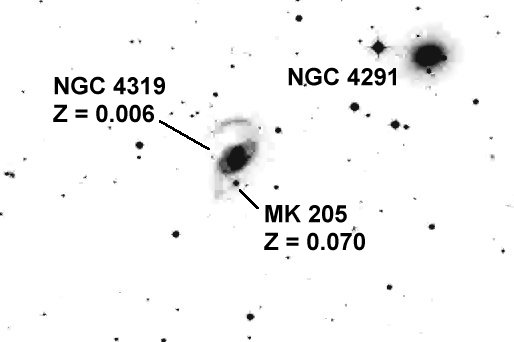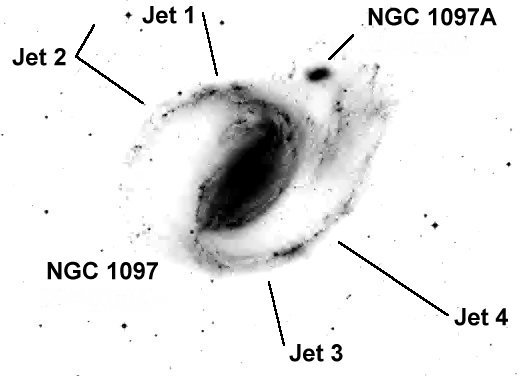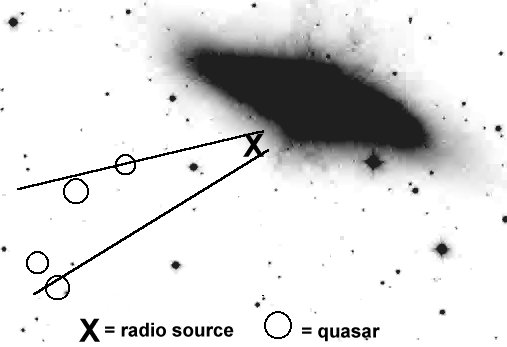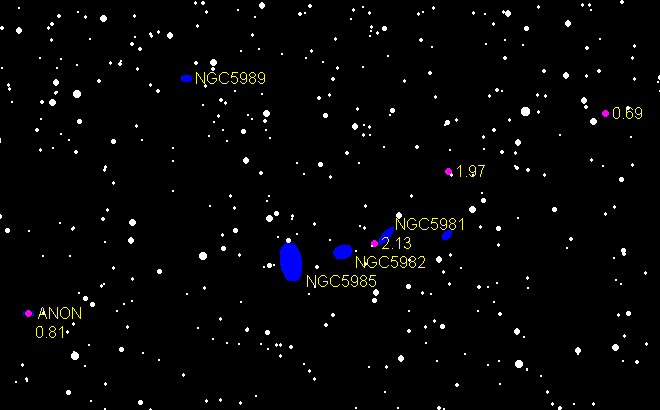And Other Redshift Anomalies
The Brightest Quasar


Quasars (quasi-stellar objects) were discovered by radio astronomers in the early 1950s. When positions could be determined accurately enough to match bright radio sources like 3C273 in Virgo to visual objects, they turned out to look just like ordinary stars. Their spectra, however, resembled nothing seen previously.
Early in 1963 Maarten Schmidt of Caltech realized that the pattern of emission lines in 3C273 matched the Balmer lines of hydrogen shifted toward the red by 16%. Assuming the conventional interpretation of redshift as correlated to distance, this placed the object more than a billion light years away! Furthermore, this meant that, with an apparent magnitude of 12.9, the object had to be more than 100 times more luminous than any nearby spiral galaxy!
It's fun to observe a quasar like 3C273 (RA 12 29 DEC +02 03), even though it looks exactly like the field star beside it. Arp has published an X-ray map of the Virgo Cluster, based upon ROSAT data, that showed a broad X-ray filament extending from the giant ellipticals in the center of the Virgo Cluster all the way to 3C273 some 10 degrees to the south and 30 times further away, according to conventional wisdom. If this apparent connection is real, the quasar is part of the Virgo Cluster.

The Bridge: Image by David Strange
With a 17.5" scope, it's not difficult to observe the most famous galaxy/quasar pair in the sky: NGC 4319/Markarian 205 in Draco (RA 12 22 DEC +7519). (The quasar-like object MK 205 is also listed in Markarian's catalog of galaxies with strong ultraviolet emission.) At magnitude 14.5, Mk 205 lies less than an arcminute southwest of the core of NGC 4319. According to the standard interpretation of redshift, it is more than 12 times further away.
When Arp took a deep exposure of the pair at Mt. Palomar, he discovered a luminous bridge of gas between the two objects that caused a furor in professional astronomy. At first it was claimed that the apparent connection was not there, but it was later confirmed by CCD imaging. The currently favored explanation appears to be that it is a background galaxy that just happens to lie in exactly the right position on the sky to appear like a connection. (A bridge is clearly visible in the above enhanced RealSky image. In fact there are two bridges! Pretty weird, isn't it?)
Although not in Arp's Atlas of Peculiar Galaxies, NGC 4319 is itself a very strange-looking galaxy. Its spiral arms seem to be coming off at the roots, as if the galaxy were exploding from within. X-ray maps of the area also show apparent connections with three other nearby quasars of much higher redshift. Arp believes that MK205 and the other nearby quasars were ejected from the galaxy, like the knots in optical jets in galaxies like M87.

Galaxy/quasar pairs are not the only apparently associated objects with discordant redshifts. NGC 1232 (Arp 41) in Eridanus is a bright face-on spiral with a typical small 15th-magnitude companion galaxy near the end of one spiral arm, not unlike M51. The companion shows the same resolution of features and knots as the main galaxy. They were universally accepted as a physical pair as long as their redshifts were catalogued as essentially equal. Then an error in the catalogs was discovered; the newly measured redshift for NGC 1232A placed it four times further away than its parent. Arp also discovered another companion, a stellar bluish object near a disrupted region in one of NGC 1232's spiral arms. It appears to lie in front of the galaxy, yet its redshift places it more than a billion light years away, 15 times further than NGC 1232 itself. The galaxy is included in An Arp Sampler.
Paul Hickson compiled his Atlas of Compact Groups of Galaxies in order to provide an homogeneous sample for further study. (See Quintets, Sextets & Septets.) One of the first things that strikes one when perusing his atlas is how many of the compact groups have members with discordant redshifts. 45 of the 100 groups have apparent members with radial velocities more than 1,000 km/s different than the median velocity of the group. 29 of the groups, including Stephan's Quintet and Seyfert's Sextet, have at least one member with a widely discordant velocity difference of at least 5,000 km/s, or a distance difference of about 250 million light years under the standard interpretation. Hickson claims that this is about what would be expected by chance (?)

Two bright galaxies from An Arp Sampler are surrounded by many quasars, illustrating Arp's argument that quasars are far more prevalent in the neighborhood of bright nearby galaxies than would be expected by chance alone. (The quasars themselves are fainter than 18th magnitude and thus not observable in amateur telescopes.) NGC 1097 (Arp 77) in Fornax is a beautiful spiral with a bright companion at the same redshift. It is surrounded by quasars which may be preferentially aligned with the optical jets visible on long exposure photographs. (Jet 2 is the famous dogleg jet).
NGC 520 (Arp 157), one of the most disturbed galaxies in the Arp Atlas, is a very peculiar object, probably another example of an exploding galaxy like NGC 3419 and M82. Even more peculiar is the long string of nearby quasars that appear to be lined up with the galactic core, as if ejected in a jet and counterjet pattern. There are also dense groups of quasars within less than half a degree of both galaxies.

M82 (Arp 337) is a very strange-looking galaxy in a large amateur scope, with a pattern of dark bands running obliquely to its major axis and a dark wedge cutting into the galaxy from the southeast near its center. Gaseous filaments apparently exploding from the galaxy's core are a prominent feature on photographs. A radio source and four quasars lie within five arcminutes of the galaxy to the southeast, all within an hypothetical ejection cone originating in the area of the prominent dark wedge.

Of all the Galaxy Triplets I have observed, my absolute favorite is the NGC 5982/5 Group in Draco. It's a trio of bright galaxies, all neatly lined up and each visually different: face-on spiral, dwarf elliptical, edge-on spiral. That's why I was thrilled to come across it in Arp's latest book as a summary example of the basic cosmological unit in the universe according to Arp. Here's what I learned:
My suggestion on the three companions is that they were ejected as quasars along the minor axis about a galaxy age ago, reached about 1/2 Mpc out, and slowly evolved into companion galaxies as they fell back toward NGC5985. That would require the minor axis of NGC5985 to have remained steady (non precessing) during the interval.
What are we to make of these observations, and others like them? Are they all just chance alignments? Or do they suggest that something is going on here that we don't understand? Make up your own mind, after examining the evidence, without relying on the "experts" to tell you what to think:
For some, astronomy faces new and unusual phenomena that call for new ideas.
For others, these phenomena are best swept under the rug.
--Geoffrey Burbidge (UC, San Diego)
